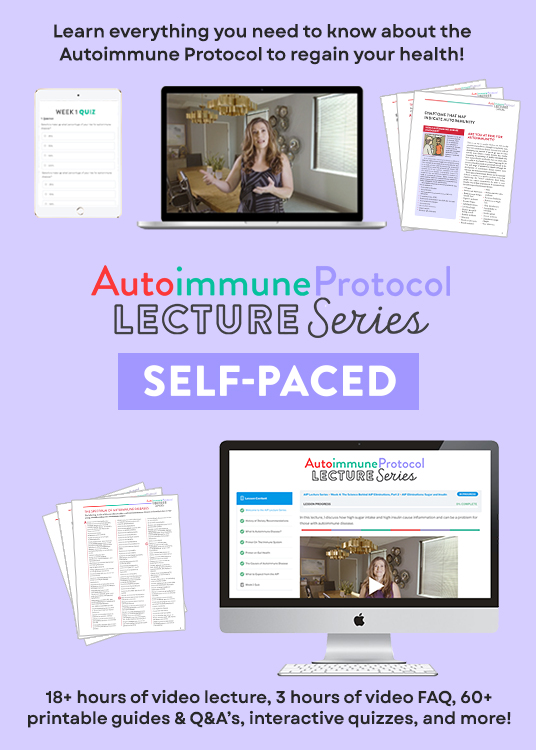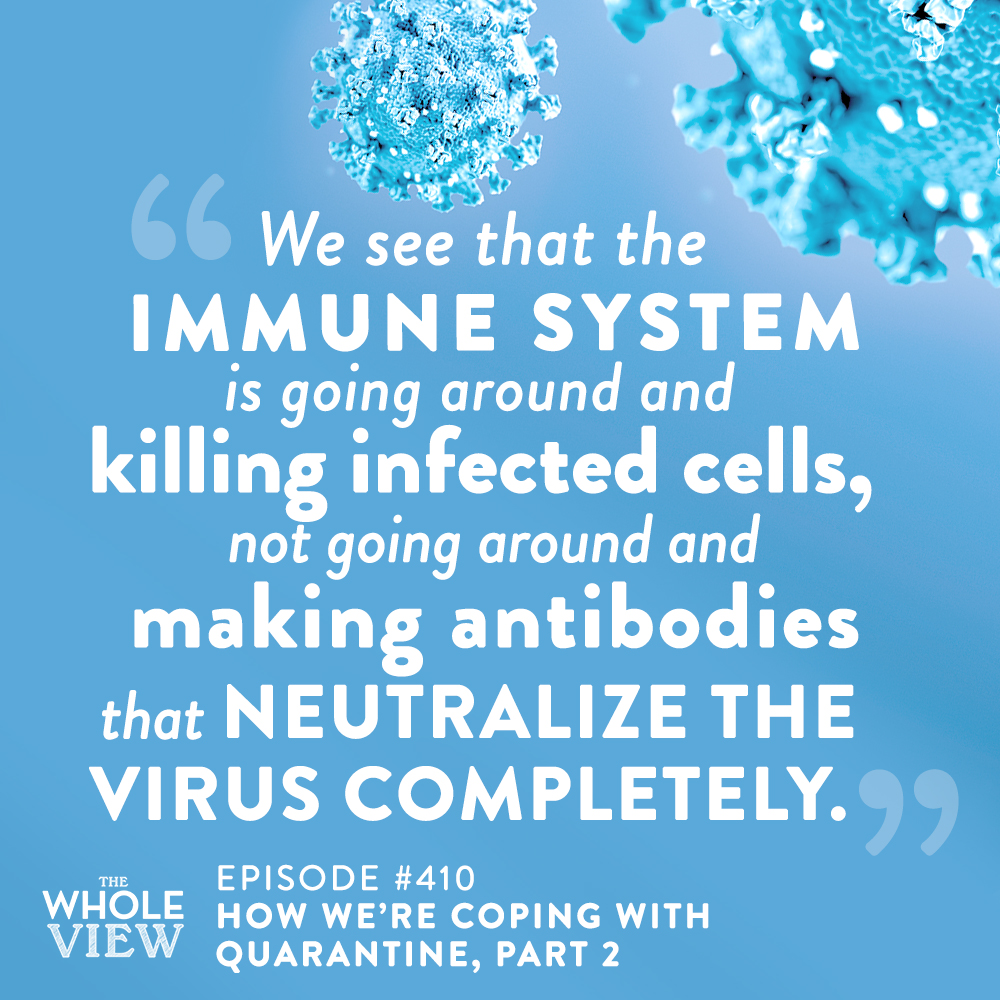Welcome to episode 410 of The Whole View. On this week’s episode, Stacy and Sarah share an update on how quarantine is going thus far. Sarah also circles back on the latest covid-19 scientific information, sharing with listeners what advances have been made. Tune in below!
Table of Contents[Hide][Show]
If you enjoy the show, please review it on iTunes!
The Whole View, Episode 410: How We’re Coping with Quarantine, Part 2
Welcome back listeners to the Whole View, episode 410. (0:27)
Stacy is going to be honest that we have had a quarantine update show on the dockets for a few weeks.
However, Stacy has been having some feels and the topic kept getting pushed back.
But this week Stacy and Sarah will be sharing their updates, and will also share updates on what is happening in the world and with science.
Stacy wanted to first say thank you to all the people who have been so supportive and have participated and supported this community.
Sarah wanted to take a moment to share a few emails that we have received.
The messages from these fans left Sarah feeling so grateful and she just wanted to take a moment to share them.
Thank you to everyone who has taken the time to write to Stacy and Sarah over the last few weeks.
Save 70% Off the AIP Lecture Series!
Learn everything you need to know about the Autoimmune Protocol to regain your health!
I am loving this AIP course and all the information I am receiving. The amount of work you have put into this is amazing and greatly, GREATLY, appreciated. Thank you so much. Taking this course gives me the knowledge I need to understand why my body is doing what it is doing and reinforces my determination to continue along this dietary path to heal it. Invaluable!
Carmen Maier

Protesting vs. Covid
Stacy wanted to take a moment to share something she is feeling frustrated by. (6:30)
Over the last few weeks, there has been a lot.
One of the things that Stacy has read about is the idea of why do we need to wear masks and social distance if people are just going to march.
And if people are marching, then we don’t need to do all this other stuff.
Why is it that this is an exception, but this other thing doesn’t exist?
Stacy wants to share her thoughts on this.
When a community of people is being oppressed and are vulnerable from a number of societal abuses and discriminations, and they want to use their voice and their rights as Americans to peacefully protest, and then we turn it around and complain.
And most of them are in fact wearing masks to do this.
Why do we have a say in this first of all?
If you genuinely felt like your life was at risk, that the life of your loved ones was at risk, then the risk of potentially getting covid doesn’t really quantify.
And it isn’t really our job or right to say how someone goes about trying to get equal rights.
What Stacy has learned over the last couple of months is that she needs to stop talking and thinking.
She hasn’t lived that life and she hasn’t had that experience and she can’t put her thoughts on someone else.
So first, this is not your choice.
Second, most of these people are wearing masks.
And third of all, there are people out there exploiting this.
Stacy mentioned this article.
This is a hard one for Stacy to understand the thought process behind.
If you don’t like it, just don’t participate.
You don’t have to be there, you don’t have to worry about covid exposure.
If you want to support this movement but are afraid to go to a march, you can do things in other ways to show your support.
If there wasn’t a pandemic, Sarah would be marching in solidarity.
However, she is trying to find as many other tangible ways to support the Black Lives Matter movement and this advocacy for equality in the absence of feeling safe going to marches.
What the Science Shows Us
Sarah feels it is important to emphasize the importance of mask use. (13:20)
One of the things that have been ubiquitous across all the Black Lives Matter protests is that you see a lot of mask use in these marches.
A lot of them where they can be practicing social distancing, are putting those measures into place.
Of course, these are all done outdoors as well.
Sarah’s blog post on face masks.
Even with regular cloth-fabric masks, it can have a filtration efficiency almost as high as surgical masks.
So when everyone is wearing them, if you have two people having a conversation and the person who is sick is wearing a mask, only 10% of the viral particles are able to escape.
The other 90% are being trapped.
And if you have that second person, the healthy person also wearing a mask, that healthy person is still filtering 90%.
So that is now taking 90% of the 10% that went through, so now only 1% is getting through.
Add in a little bit of distance and some airflow, you are now talking about a situation where the likelihood of infection is way lower.
So when you are in these situations where everyone is wearing masks, that is a huge protecting factor.
The other part that is helping to protect the protestors is the fact that they are outdoors.
There was a study just published this month that showed that with just sun exposure, 11 to 34 minutes in the midday sun in most US cities was sufficient to deactivate 90% of the virus.
And that is because it is quite sensitive to UV.
The combination of most protestors wearing masks and these being held outdoors has been what is protecting them.
Number Spikes
There are plenty of spikes in covid that are related to indoor gatherings across the country. (16:13)
The indoor environments are still very challenging.
And a lot of these spikes are also related to indoor gatherings without mask use.
Protesting has so far not caused a spike in cases.
There were four community testing sites set up in Minneapolis for people who attended protests showed, which showed a 1.4% positive rate.
This is basically the same positivity rate that you would expect for community spread for any community in this country right now.
Our full positive rate is climbing up towards 10% again in this country.
This is obviously different than these community testing sites that were designed to monitor whether or not coronavirus is being spread through the protests.
However, at the same time, this is data showing that at least for now, and probably largely attributed to mask use, we are not seeing that the protests are causing spikes.
A Quarantine Update from Stacy
Stacy is in a desperate state to get out of her house. (18:40)
It has been since February, and she has three boys, and Matt works all of the time.
He had off while they were home recovering from covid, but once he went back he has essentially been on demanding work schedules.
Virginia is now in phase two of their re-open.
Masks are required if you go anywhere in public.
Their numbers are going down.
Virginia doesn’t get to progress to the next level in their reopening phase until they reach certain benchmarks that show improvements.
Matt and Stacy have decided to take a glamping trip.
They have rented a rustic cabin, so they will bring all of their own linens and pretty much everything.
It will be a week outside in the wilderness on a lake where the boys can enjoy water activities and be outside and be active.
Their neighborhood hasn’t been social distancing as much as Stacy would like.
The kids have not been able to leave the yard, and they are over it.
They are all over it.
So Matt got days off finally.
It will be a vacation with the same social distancing plan.
Stacy will let listeners know how it goes.
A Quarantine Update from Sarah
There was a similar conversation in Sarah’s household about going on a camping trip this summer, but they decided not to go. (22:44)
They typically go to a state park up in the mountains when they go camping, and while they are in a tent, they use shared bathrooms at the camping sites.
Sarah is experiencing a lot of stress around how her state is opening up.
In part, this is because of mask use.
If you look at a poll of what people think of masks, everyone has positive things to say.
Eighty to ninety percent of people are pro-mask.
Around 1/3 of Americans are wearing masks at all times outside of their homes.
One-third of Americans are sometimes wearing masks outside of their homes.
And 1/3 of Americans are not wearing masks at all.
Last time when Sarah went grocery shopping, she only saw 1/4 of people wearing masks.
Sarah is definitely concerned about the possibility of having a more severe course of covid if she gets it.
So to be in a grocery store when 1/4 of the people were wearing masks and social distancing, and the other 3/4 of the people not wearing masks were not being respectful of boundaries.
Sarah feels like it is selfish to behave like this, and has since been having her groceries delivered instead.
She has not had an anxiety attack as she did after that experience in years.
It was such an awful experience to be put into that position.
The thing that stresses Sarah out is watching decisions being made that aren’t supported by the data.
Stress Around Opening Back Up
In Georgia, they have seen this plateau of cases, but the plateau is at a very high level. (27:12)
There is no place that is exempt.
It feels harder for Sarah to protect herself when it is not a community action to protect each other anymore.
This is not to say that everyone is disregarding the recommendations being made, but there are just enough people disregarding it to make Sarah feel like it is not safe to go out.
That has been the hardest part for Sarah.
They haven’t announced how they are going to handle school in the fall.
Sarah’s husband’s work is still trying to figure out all of their logistics for what they will do.
So they are still waiting on information there before making decisions on how they will respond.
Sarah feels much safer at home and in her own yard and her own neighborhood.
It has been really challenging for Sarah psychologically.
There are ways that we can be opening up the economy that is safer than what she is observing around her.
Antibody Testing
One of the questions that Stacy has gotten many times is, does she have antibodies. (29:39)
Stacy does not have antibodies.
Matt and Stacy took a test early that they knew had a high false-negative rate, so she attributed it to that and she wasn’t worried.
Then they special ordered a more accurate test and Stacy took that last week and was crushed to find out that she does not have antibodies.
This news overwhelmed Stacy because she had chickenpox twice, and there is some research to suggest that there are different types of immune responses to getting different kinds of illnesses.
The body could then have a worse case the second time.
Sarah also did antibody testing two weeks ago, which also came back negative.
There are three different pieces to talk about this.
One, how good the antibody tests are, and the answer for most of them is not that.
Our immune systems are not fully developed until we are about one.
It is fairly well-known that if you get one of these childhood diseases, like chickenpox, before you are one, there is a higher likelihood of not developing immunological memory.
Immunological memory is the ways that our immune system remembers a specific pathogen so that the next time you are exposed to that pathogen it can mount a response before it replicates enough time to have symptoms.
This is why the vast majority of people only get chickenpox once.
For some people who are immune-compromised, this can definitely impact immunological memory.
There have been hundreds of antibody tests that have gotten this emergency use authorization, and they are not all good.
In fact, a small percentage of them are good.
It is really important to know three different things about that test before selecting which one to use.
The false-negative rate, the false positive rate, and if the test looks for both IgG and IgM.
Stacy and Sarah both used Access Labs.
For more on tests, see here and here.
More on Testing
We still don’t know with covid what level of antibodies is enough to say you are protected. (38:54)
This is where things get really complicated.
There was a study published in Nature Medicine two weeks ago that actually looked at antibody production and compared severe cases versus mild.
All of these antibody tests have sensitivity and specificity rates that are measured by confirming their test against samples from patients who were hospitalized with covid.
So all of these antibody tests are confirmed against severe cases.
What this Nature paper showed is that 40% of the people who were asymptomatic had no antibodies by the time their infection was over.
So they actually showed that these people who were asymptomatic were shedding virus for an average of nineteen days.
By the end of those three weeks, they had no measurable antibodies.
12.9% of their symptomatic group also has no antibodies by the time their symptoms were over.
So if you are not going to measure antibodies in that perfect window there is a really high percentage chance that you are missing antibodies.
If you have a mild case you don’t even know necessarily know when that window is.
We can deduce just from what we know about how the immune system works that a mild case would be much more similar to an asymptomatic case in terms of antibody production, then to a severe case.
So antibodies might not be a really great test for measuring immunity.
Immune System Detection
What is fascinating about the SARS-CoV-2 virus is that it evades detection by our immune systems. (41:17)
Which is one of the reasons why it is a long illness.
It gets a much longer time than normal to ramp up its viral replication before our immune system recognizes an invader.
The virus itself can evade detection from our immune system by two different mechanisms.
One is by interfering with the production of a class of pro-inflammatory cytokines.
Long-term immunity may be via T cells and not antibodies, and Sarah explained this in greater detail.
We have all of these studies showing now that the immune response to covid is type 1 driven.
And that actually there is no change in B cell activation compared to a healthy person.
So our immune response is not actually antibody driven.
What is happening is that our immune system is going around and killing infected cells, not going around and making antibodies that neutralize the virus directly.
There is a little bit of that, but not a ton.
This is why we are not seeing the type of antibody formation that would help us measure immunity, which is not how our immune system is responding to this virus at all.
So there are a lot of different ways that our immune system can remember a pathogen.
We can have immunological memory through T cells.
So we actually know from studies of SARS-CoV-1, which caused the SARS epidemic in 2002 and 2003, that that virus was also the response was also Th1 driven and not Th2.
We know that memory T cells can persist in patients for at least four years after infection.
However, we don’t know yet what happens to those memory T cells if it is long-term immunity or just a few years.
Either way, at least for the near future, we can deduce that if you have had it you are still immune, but it is through this thing that we don’t really have the testing capacity for.
Research labs can test for memory T cells via a blood sample, but there is no test that has been developed to measure immunity in this way for anything else.
It is not a normal test, it is not a normal thing, it is a technique used in research, but not phlebotomy.
What a negative antibody test means for someone like Sarah is that she probably hasn’t been exposed.
For Stacy, it shows that she had a mild enough case that she didn’t develop antibodies.
However, her immune system is remembering it through T cells.
For more information on the research surrounding T cells see here, here, here, and here.
Closing Thoughts
The answer is the same answer that brings us back to the top of the show. (47:46)
Stacy doesn’t wear a mask for her, she wears a mask for somebody else.
This is a topic that she wants to reiterate one more time.
Had Stacy not have been wearing a mask and protecting others, who knows what could have happened to someone else.
You never know if you have something and you are asymptomatic and could be passing it along to someone who is higher risk.
No matter how healthy and fit you are, you are not safe from a severe course.
We don’t want this for anyone.
It is our job to keep people protected and wear masks.
If someone is going out and not wearing a mask, you are impeding your decision on somebody else in a way that could harm them.
It is our job to be mindful of and take care of others.
Stacy understands that wearing masks is new and different, but that is ok – that is what change is.
We are implementing these changes to protect not just ourselves but other people.
Sarah appreciates Stacy for raising these points.
She has been shocked to see people’s vehemence against masks that she has seen online.
Sarah can fully appreciate the feeling of being over it and just wanting things to return to normal.
The problem is that wanting things to be normal is not enough for things to actually be normal.
We risk the lives of the most vulnerable in our community by pretending that it is done and over.
We are at 2.2 million confirmed cases in the US, granted this also includes the people who have recovered.
But we are seeing in roughly half of the states, cases are spiking again.
This is in large part because of the reliance on opening things back up because we all are eager for things to get back to life as normal.
However, normal can only be achieved if we each take responsibility to not just protect ourselves, but to also protect others, which includes social distancing, wearing a mask, and hand washing.
It is the thing that we do to take ourselves out of the pool of people spreading, which is how we get the reproductive number below 1 so that this can be a virus that fizzles out.
Sarah feels the frustration and the longing for normalcy, but at the same time, this pandemic is still here.
Until we have effective treatments or preventatives, this is what we’ve got – social distancing and mask-wearing.
If we can’t figure out masks we are going to end up shut down and stuck in our homes again.
One of the reasons why we have a plateau in so many states or cases decreasing is more related to the weather than it is related to mask-wearing and social distancing.
When things get going in the fall, if we can’t figure this out by then, the consequences are going to be more cases and more people dying.
Sarah will not contribute to that and will wear a mask and social distance for as long as it takes us to get through this pandemic.
Thank you listeners for tuning in.
Stacy hopes that you are doing well, she knows this is a difficult time.
Please remember that we are trying to help others as well as help ourselves.
The things that are shown to reduce risk to continue to be done even if it is not required.
We hope that you stay safe!
And we will be back again next week! (58:53)










